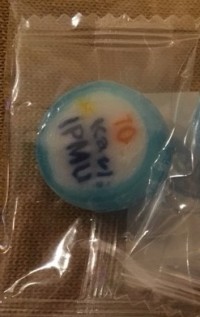
Looking forward: Hitoshi Murayama. (Courtesy: Kavli IPMU)
By Michael Banks in Tokyo, Japan
Just a couple of weeks ago the Kavli Institute for the Physics and Mathematics of the Universe (IPMU) marked its 10th anniversary.
Located on the University of Tokyo’s Kashiwa campus, the institute held a big celebration that was attended by hundreds of researchers including Nobel prize winners. The occasion was even marked by the creation of a bespoke sweet (see image below right).

Marking the occasion.
Building an institute from scratch is no easy task, but in such a short time it has gone on to be one of the leading centres in the world.
That is thanks to its unique approach where astronomers, mathematicians and physicists come together all under one roof to tackle five fundamental questions about the universe: how it began? What is it made of? What is its fate? What are its fundamental laws? And why do we exist in it?
Today I met with IPMU director Hitoshi Murayama, who outlined his plans for the coming decade.
The IPMU is part of Japan’s World Premier International Research Center Initiative (WPI), which began in 2007 with the creation of IMPU and four other institutes. The programme was initiated to attract foreign researchers and also reform the university system in Japan, which many complained was too rigid.
In both regards the IPMU has been a roaring success. The WPI mandates that around 30% of an institute’s researchers come from abroad. But the IPMU instead has around 50%. “It just happened like that,” says Muryama. “But I think that having an equal percentage of Japanese to non-Japanese also makes people from abroad feel more comfortable.”
The IPMU’s 140 researchers publish around 450 papers each year and around 60% of them have international coauthors. This compares to about 10% of papers for most Japanese universities.
Murayama spends around half his time at the University of California, Berkeley. He said that when he began the IPMU he was the only one at the university to hold such a joint position with a foreign institution. Now there are 72. “Initially, I was an anomaly,” he says.
The institute doesn’t just cover theory. It has its owns labs and one project that the IPMU is heavily involved in is LiteBIRD. This is a space-based mission that will attempt to detect B-mode polarization of the cosmic microwave background.
Costing $300m, researchers are hopeful that it will be approved next year by the government with a possible launch slated for 2025.
Indeed, a sign of the IPMU’s collaborative nature is apparent at the daily 3pm “tea time” meeting in which researchers come together to discuss what they are working on and hopefully foster collaborations. Murayama showed me examples of where such discussions have not only led to ideas being exchanged but new avenues of research.
He will be hoping that the next 10 years brings more of the same.
Guidelines
Show/hide formatting guidelines
this text was deletedwhere people live in harmony with nature and animals</q>
Some text